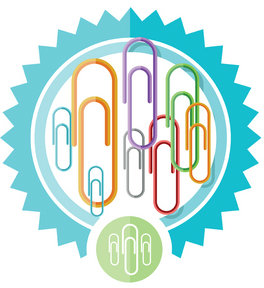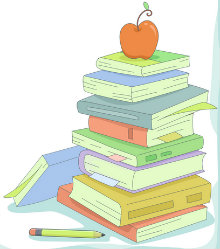Some Old-School Ideas for Today’s Classrooms
 By Anne Anderson
By Anne Anderson
Do you ever feel like you are fighting a losing battle? Think about it. You are surrounded by a bunch of young adolescents, affectionately known as knuckleheads and commonly referred to as middle schoolers. You are attempting to create thinkers, readers, writers, mathematicians, scientists, and the like.
Seriously! It’s not easy, especially when supplies are low, when technology is sparse, and when we have already spent too much of our own money for learning stuff. That’s when I look around the classroom and think about ways I can repurpose what I have and help remedy this dilemma.
Using three staples of most classrooms – a clock, paper clips, and old textbooks/workbooks – here’s some old-school innovation that can help teachers use what you have to get what you want. (Be sure to add your own ideas in the comments!)
The Clock

Suppose the lesson calls for learning groups to discuss four questions/problems and I intend to spend approximately 10 minutes on this portion of the lesson. My experience has shown that most groups spend too much time on the first question and then race through the remaining items.
I know that I often lost track of time and this activity stretched on too long. Announcing an exact time to complete a specific task encourages students to work quickly and efficiently and keeps the lesson on target. Here’s a solution that has worked for me and my students.
I set the timer for 2 minutes. When it sounds, I remind the groups to finish up number one and move ahead to the second question. This is generally sufficient to keep them on track and ensure that they cover all the discussion items. I reset the timer in order to give a two-minute warning.

If the presentation is to be five minutes long, have one student set the timer for four minutes; he/she will signal the presenter when there is one minute remaining. The other student uses the stopwatch mode and records the actual presentation time. District policy on cell phones, as well as your nerves, will determine if this activity is viable!
A friendly game of Quick Think encourages quick recall. Loosely patterned after the old TV show Beat the Clock!, it provides an opportunity to review previously taught content and general world knowledge. A week-long series of Quick Think competitions before holidays is a great way to get in the spirit, loosen things up a bit, and channel excess energy in productive directions. Here’s one method you can use or adapt.
Paper Clips
For me, it was either a feast or famine of paper clips. If you find yourself with an abundance of paper clips, use them for Talking Chips. Based on the Kagan Structures, this activity gives everyone an opportunity to speak in small group discussions.
Establish the ground rules first –
- no bending or changing the shape of said paper clips, and
- no creating paper clip chains.

Each group member receives 3 – 4 paper clips. As a student talks, a paper clip is placed in the center. Once a student has used all his/her paper clips, that’s it for talking. When all the paper clips are in the center, then each participant may speak again by removing a paper clip.
As you move about the room, eavesdrop on the group conversations to determine how best to provide closure for the activity and address any misunderstandings or misconceptions. Be sure to collect the paper clips or you will have a paper clip famine!
Old Textbooks / Old Workbooks
Do you have a shelf or box of old textbooks or workbooks that collect dust but cannot be discarded? Now might be the time to do some Picking & Choosing! Examine these resources and pick and choose activities that help students build vocabulary, strengthen reasoning skills, and improve problem-solving skills. These texts are also useful when designing an assessment.

Use the Practice Test Lessons found at the end of a chapter/unit as a resource for items that feature charts, graphs, or images. Look for and select questions that require higher-level thinking. Now you have additional examples to use when teaching students how to analyze test questions.
Examine that stash of books/workbooks one more time. Is there an activity than can be reworked and updated for use in a center or work station? Is there something that will work for students in in-school suspension? Is there material that can be used in your emergency sub plans?
You’ve got this stuff in your classroom! Use it to get what you want: thinkers, readers, writers, mathematicians, scientists, and the like!
Teachers are amazingly resourceful. Share a “repurposing” idea of your own in the comments.
Anne Anderson finally got out of the 8th grade after 24 years and 9 weeks. She spent the next 9 years sharing her expertise in literacy and writing with K-12 teachers and administrators throughout the district. She credits National Writing Project and Poetry Alive! as turning points in her growth as a teacher. She now shares her expertise nationwide as an educational consultant and through her website and her bi-monthly newsletter, Spotlight on Success.

































